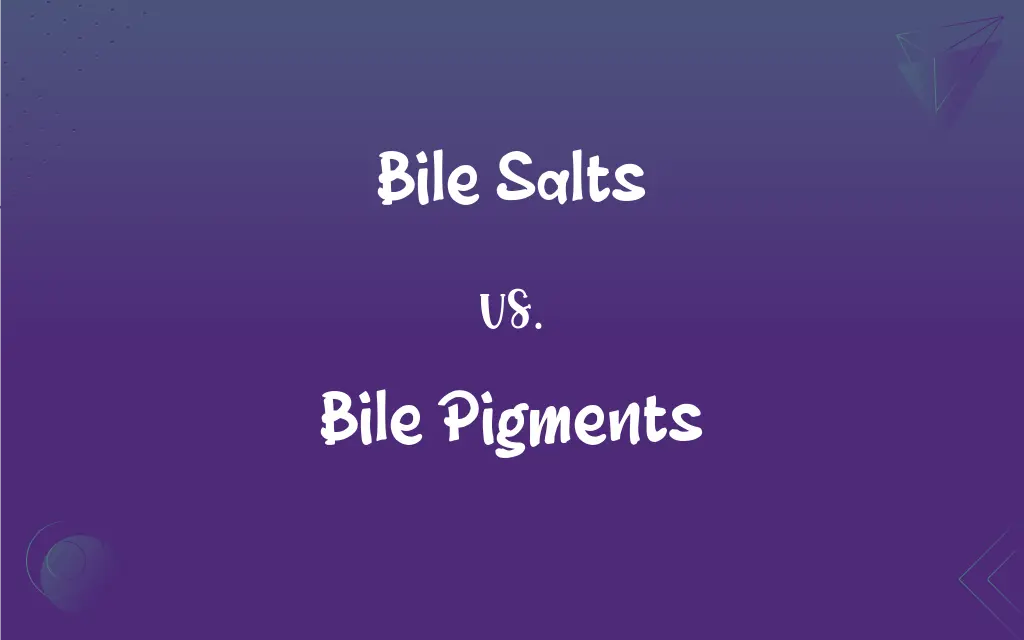Bile Salts vs. Bile Pigments: What's the Difference?
Edited by Aimie Carlson || By Harlon Moss || Published on January 24, 2024
Bile salts aid in fat digestion and absorption by forming micelles, whereas bile pigments, like bilirubin, are waste products from the breakdown of red blood cells.

Key Differences
Bile salts are compounds synthesized from cholesterol in the liver, essential for the emulsification and absorption of fats. Bile pigments, particularly bilirubin, are byproducts of hemoglobin breakdown from old red blood cells, giving bile its characteristic color.
In digestion, bile salts play a crucial role by breaking down large fat globules into smaller micelles, making them accessible to digestive enzymes. Bile pigments, on the other hand, do not participate in digestion but are important indicators of liver function and health.
Bile salts are reabsorbed in the intestine and recycled by the liver, a process known as enterohepatic circulation. Bile pigments, after being excreted into the bile, travel through the digestive tract and are eventually eliminated from the body.
Abnormalities in bile salt levels can lead to digestive issues and malabsorption of fats. Alterations in bile pigment levels, especially bilirubin, can indicate liver disorders or hemolytic conditions.
The composition of bile salts varies among species, but they typically include cholic acid and chenodeoxycholic acid conjugated with amino acids. Bile pigments, primarily bilirubin, result from the breakdown of heme, a component of hemoglobin, in a process involving the liver, spleen, and bone marrow.
ADVERTISEMENT
Comparison Chart
Primary Function
Aid in fat digestion and absorption
Waste products from red blood cell breakdown
Role in Digestion
Emulsify fats, forming micelles
No direct role in digestion
Biological Origin
Synthesized from cholesterol
Byproducts of hemoglobin breakdown
Circulation in the Body
Reabsorbed and recycled (enterohepatic circulation)
Excreted and eliminated from the body
Indicative Health Conditions
Abnormal levels suggest digestive issues
Altered levels can indicate liver or blood disorders
ADVERTISEMENT
Bile Salts and Bile Pigments Definitions
Bile Salts
They are key components of bile, essential for fat absorption.
Without bile salts, the body struggles to absorb fat-soluble vitamins.
Bile Pigments
Bile pigments are eliminated through feces and urine.
The breakdown products of bile pigments color the feces brown.
Bile Salts
Bile salts are involved in enterohepatic circulation.
Bile salts are absorbed in the intestine and returned to the liver.
Bile Pigments
Bile pigments are involved in the body's waste disposal.
Bile pigments help in the excretion of waste products from the bloodstream.
Bile Salts
Bile salts are amphipathic molecules.
The amphipathic nature of bile salts enables them to interact with both fats and water.
Bile Pigments
Bile pigments are byproducts of red blood cell breakdown.
Bilirubin, a primary bile pigment, is derived from hemoglobin.
Bile Salts
Bile salts are cholesterol-derived compounds that aid in fat digestion.
Bile salts emulsify dietary fats, making them easier to digest.
Bile Pigments
Elevated bile pigments can indicate liver dysfunction.
High bilirubin levels can lead to jaundice, a yellowing of the skin and eyes.
Bile Salts
They play a role in cholesterol metabolism.
Bile salts help regulate cholesterol levels in the body.
Bile Pigments
They give bile its yellow-green color.
The color of bile is attributed to the presence of bile pigments.
FAQs
How do bile salts function in digestion?
They emulsify fats into micelles for easier digestion.
What is the role of bile pigments in the body?
They are waste products eliminated through feces and urine.
Are bile salts reused by the body?
Yes, they undergo enterohepatic circulation.
Are bile salts produced in the liver?
Yes, they are synthesized from cholesterol in the liver.
Can bile pigments cause jaundice?
Yes, high bilirubin levels can lead to jaundice.
What are the symptoms of bile salt malabsorption?
Diarrhea and fat malabsorption.
What are bile salts?
Compounds that aid in fat digestion and absorption.
How are bile pigments excreted?
Through feces and urine.
What are bile pigments?
Byproducts of red blood cell breakdown.
What causes elevated bile pigments?
Liver dysfunction or increased red blood cell breakdown.
Do bile pigments have any digestive function?
No, they are not involved in digestion.
Can bile salts indicate health issues?
Yes, abnormalities can suggest digestive or cholesterol problems.
What does the color of bile pigments indicate?
It indicates the health of the liver and red blood cells.
Can a diet affect bile salt production?
Yes, diet can influence cholesterol and thus bile salt synthesis.
What is a common bile pigment?
Bilirubin is the most common bile pigment.
Do bile pigments have any therapeutic use?
Not directly, but they are important diagnostic indicators.
What is the significance of bile salts in nutrient absorption?
They are crucial for absorbing fat-soluble vitamins.
Are bile pigments always harmful?
No, they are normal waste products, but high levels can be harmful.
What happens if bile salts are deficient?
Fat digestion and vitamin absorption can be impaired.
Are bile salts and pigments found in all animals?
Yes, they are present in most vertebrates.
About Author
Written by
Harlon MossHarlon is a seasoned quality moderator and accomplished content writer for Difference Wiki. An alumnus of the prestigious University of California, he earned his degree in Computer Science. Leveraging his academic background, Harlon brings a meticulous and informed perspective to his work, ensuring content accuracy and excellence.
Edited by
Aimie CarlsonAimie Carlson, holding a master's degree in English literature, is a fervent English language enthusiast. She lends her writing talents to Difference Wiki, a prominent website that specializes in comparisons, offering readers insightful analyses that both captivate and inform.






































































